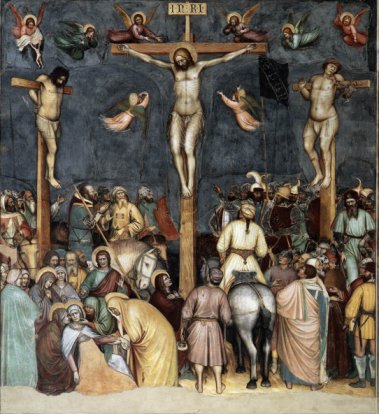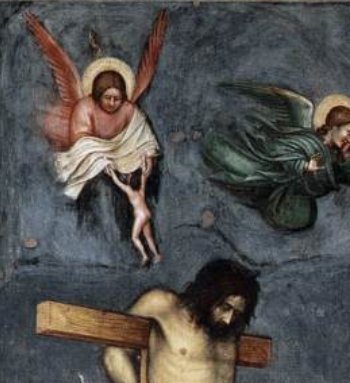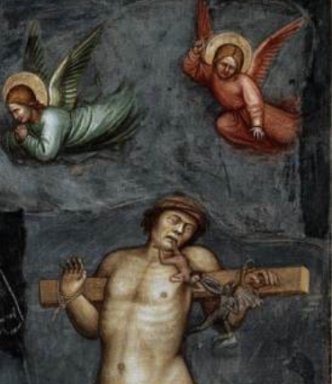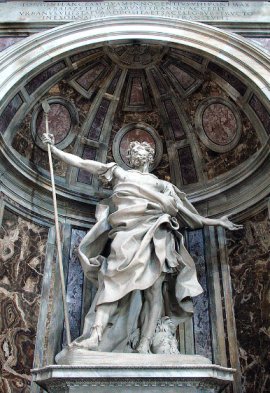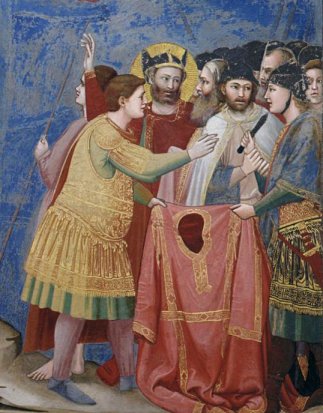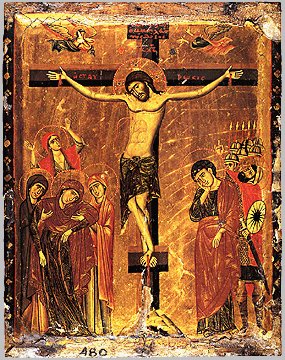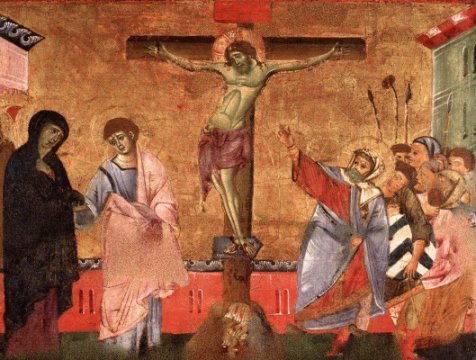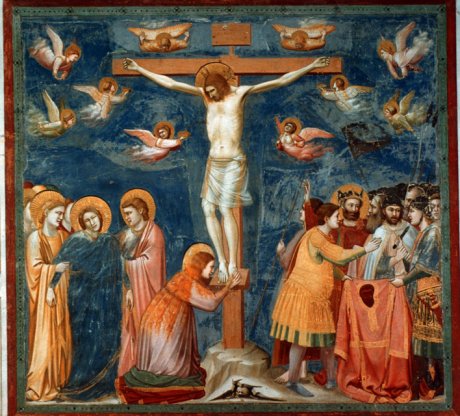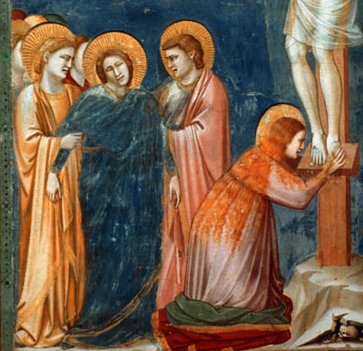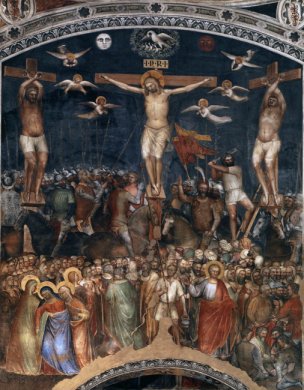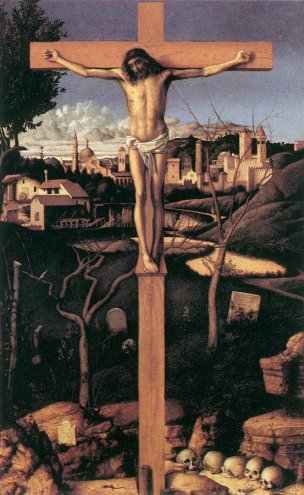|
The Crucifixion - who was there? |
|
| There seems to be a deep need in human nature to provide names to real or legendary characters that are not named in the original sources. This is certainly true in the narrative of the Crucifixion. |
|
The two thieves The two thieves crucified alongside Christ have been the focus of a number of legends. The Arabic Infancy Gospel tells us that the Holy Family met them on the The Flight into Egypt. they are usually described as 'the good thief' and 'the bad thief'. The good, or penitent, thief is generally known as Dismas. He is sometimes known as Saint Dismas, though he is not officially a saint. Other legends give him a different name. The bad thief is known as Dumachus in some legends, Gestas in others. Dismas demonstrates the idea that true penitence with bring salvation, however late it happens. Luke puts it this way: And he said unto Jesus, Lord, remember me when
thou comest into thy kingdom. And Jesus said unto him, Verily I say unto
thee, To day shalt thou be with me in paradise. (Ch 23
v42/43 |
|
|
|
|
| Let's look at the thieves in detail. Dismas is on his way to Paradise, but no such luck for Dumachis; a devil has got hold of him, and an angel is showing which way he is heading. | |
|
|
|
Roman Soldiers Probably the best known Roman soldier present at the crucifixion is John Wayne in The Greatest Story Ever Told (1965) but he doesn't get a mention in the Gospels. Two Roman soldiers are mentioned - the one who gives Christ vinegar to drink using a sponge, sometimes named Stephaton, and the one who pierced his side with a spear, usually named Longinus. The names, apparently are derived from 'spongebearer' and 'lancebearer' so not much imagination shown there. |
|
|
Longinus, to whom the
well known John Wayne line 'truly this man was the son of God'
(Mark 15 v 39) was often attributed, had a chequered career after the
crucifixion, all of which is too involved to recount here. One legend
states that he was a blind man, miraculously cured of his blindness when
Christ's blood sprayed on to his eyes. A blind soldier? And how
did he know where to point the spear? No, not entirely convincing.
The Golden
Legend can be consulted if you would like to know more, or, more
succinctly, look up Longinus on Wikipedia. He eventually and somewhat
mysteriously became a saint, and here he is in St Peter's in Rome
sculpted by no less an artist than Bernini. Not all versions accept this attribution. On the right below is a detail from the Crucifixion by Giotto in the Scrovegni chapel, Padua. (The complete fresco is below.) We can see the Roman soldiers fighting over the rather splendid gown of Christ. Behind them, haloed, is the soldier making that pronouncement about Christ. Clearly he is not the lance bearer, who is standing behind him. |
|
|
|
|
The mother of Christ and 'The most beloved', Mary Magdalene and others. This reference is only found in John: Now there stood by the cross of Jesus his mother, and his mother's sister, Mary the wife of Cleophas, and Mary Magdalene. When Jesus therefore saw his mother, and the disciple standing by, whom he loved, he saith unto his mother, Woman, behold thy son! Then saith he to the disciple, Behold thy mother! And from that hour that disciple took her unto his own home. (19 v25 - 27) 'The Most Beloved' is always identified with John the Evangelist. He and Mary are typically shown on either side of the cross, as in the Crusader icon on the left below, which makes for a balanced image. The panel by Guido da Siena on the right is interesting as it groups John and Mary together on the 'good' or right hand side of Christ. John is comforting Mary, giving a more emotional appeal to the painting. Again, the haloed figure on the left of Christ is soldier declaring 'truly he was the son of God' and again he is clearly not the lance bearer. |
|
|
|
|
| Giotto's fresco in the Scrovegni Chapel in Padua has more of the characters mentioned by John. These women are also in the Crusader icon above. |
|
|
|
|
Mary (in blue) is being comforted by John and by her sister. Mary Magdalene, clearly identifiable by her hair, kneels at the foot of the cross. It has been suggested that the prominent position of the Magdalene reflect the function of the chapel; a symbol of atonement. The Magdalene was (supposedly) a reformed prostitute, Reginaldo Scrovegni a reformed usurer. |
|
Jewish Priests and others Mark and Matthew both report the presence of high priests, elders and scribes, busily joining in with the mocking of Christ. One might think that at such an important festival they would have had better things to do, but for the gospel writers they needed to be there to signal their guilt. Matthew and Mark mention 'those passing by reviling him and wagging their heads'. Luke mentions bystanders, and Christ's acquaintances and women who followed him from Galilee. It sounds a crowded scene, and some artists have gone to town on this, like Giusto de' Menabuoi |
|
|
|
|
